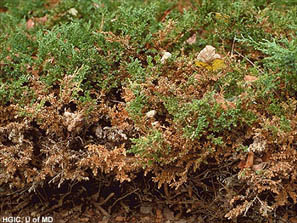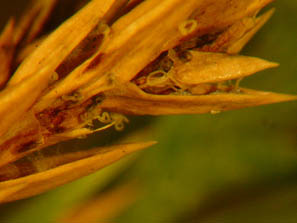Shoot Blights on Juniper and Arborvitae | |
|---|---|
| June 2, 2008 | |
|
Over the past 2 weeks, the Plant Clinic has received many samples and/or calls about junipers and arborvitae with shoot blight. The foliage is yellow, pale green, or brown. Sometimes only tips of branches are affected. Other times the injury is on the exposed south or west sides of plants. Sometimes the symptoms have spread over the plant. Always the question is, “What disease is killing my plants?” Some of the samples have been free of disease but obviously affected by environmental stress. In some areas, drought in 2006 and 2007 has caused root injury; then top decline followed. A few cases were traced to improper planting depth (too deep). Other factors to consider are girdling roots, mechanical root injury, transplant shock, waterlogged soil, rodent feeding on the trunk, and girdling by wires or twine. Look at the pattern of injury for clues to the cause. Most of the listed factors cause a uniform distribution of injury. Injury on the south or west sides of plants may be the result of added stress of heat and wind. The most common infectious shoot blight of juniper (including red cedar) and arborvitae in Illinois is Phomopsis blight.  The first symptom is yellow spots at the tips of the youngest growth. Browning and death of new shoots may follow, typically killing 4 to 6 inches of new growth at the tips of stems. A gray band of tissue at the base of the affected shoots contains pinhead-sized fruiting bodies. In warm, moist weather, the spores ooze from these fruiting bodies in tendrils  and are splashed to succulent new growth, continuing the cycle of infection. Older plants withstand infection better than young plants. Phomopsis can be controlled by removing dead tissue and spraying fungicides to protect new growth. New growth is susceptible when it is still yellowish green. Deep green needles are not susceptible. Registered fungicides are listed by host in the Illinois Commercial Landscape & Turfgrass Pest Management Handbook or the Home, Yard & Garden Pest Guide, available at https://pubsplus.uiuc.edu/. Kabatina blight looks much like Phomopsis blight but affects older growth. This fungal disease follows injury such as winter injury or drought stress. Tips of branches show symptoms in early spring, but this is last year’s growth. The problem does not spread to new growth as it appears. If new growth is affected, then Phomopsis blight is probably to blame. The two diseases can be discerned by differences in spores. It may be helpful to obtain a positive laboratory diagnosis to plan a useful management scheme. Fungicides are not useful for Kabatina blight. Resistant varieties are available for both Phomopsis blight and Kabatina blight, but not in the same species. For a list of some resistant varieties, consult this summary article in an Iowa State University newsletter: http://www.ipm.iastate.edu/ipm/hortnews/1996/7-26-1996/prefevergrn.html. A more recent listing can be found on pages 204 and 205 of Diseases of Woody Ornamentals and Trees in Nurseries, edited by Jones and Benson. Cercospora blight is a third fungal blight that may occur on junipers and arborvitae. Older needles on lower branches are affected first. Infection may move upward within the tree. Only needles are infected, not the stems. Often the only healthy growth is in tufts at the tips of branches. For more about Phomopsis blight, consult Report on Plant Disease, no. 622, available online at http://www.ag.uiuc.edu/~vista/abstracts/a622.html. | |
| Author: | Nancy Pataky |
